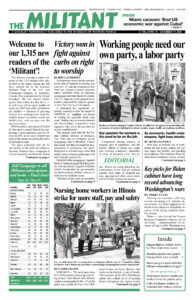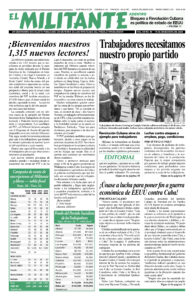Ethiopian soldiers seized Mekelle, the capital of the Tigray region of northern Ethiopia, Nov. 28. Prime Minister Abiy Ahmed claimed the central government had taken the entire province. That same day the ousted Tigray People’s Liberation Front fired long-range missiles into Asmara, Eritrea’s capital, charging the Eritrean government is backing the Ethiopian offensive.
TPLF leader Debretsion Gebremichael told The Associated Press Nov. 30 that the fighting would “continue until the invaders are out.” His forces fled to their mountain bases.
The conflict is over control of resources and power in this crucial area in the Horn of Africa, at the gateway to the Middle East. Washington, Beijing, Ankara and other capitalist powers have a major interest in the outcome.
Abiy launched the war Nov. 3 after charging that the Tigray People’s Liberation Front, which headed the regional government, had attacked a central government army base and was planning to secede from the country.
The Tigrayan forces are heavily outgunned. The Ethiopian army has at least 23 fighter jets and 20 helicopter gunships, many missile systems and hundreds of tanks and other armored vehicles.
Some 45,000 Tigrayans have fled to refugee camps in neighboring Sudan and tens of thousands have been displaced.
Ethiopia is the second most populous nation in Africa, with 116 million people and some 70 tribal groupings and 100 languages. The largest ethnic group is the Oromo, with 35% of the population.
Today’s conflict has roots that go back over a century. In 1974, Haile Selassie, the “emperor” of the country since 1930 and ally of U.S. imperialism, was overthrown by junior military officers, amid an uprising of peasants and workers.
At the time of Selassie’s overthrow, 90% of Ethiopians were engaged in small-scale agriculture or nomadic livestock raising. Half of the peasants were tenants or sharecroppers deeply indebted to their landlords. The Ethiopian Orthodox Church owned up to one-third of the land.
The new military government, known as the Dergue, adopted far-reaching reforms, confiscating land from the landlords, distributing it to peasants, and cancelling their debts. It also banned strikes and protests, arrested trade union leaders and maintained Selassie’s reactionary war against both the Tigrayan people and Eritrea, which had been annexed by Selassie in 1952. The Dergue rule became increasingly dictatorial.
In May 1991 a rebel coalition headed by the Tigray People’s Liberation Front entered the Ethiopian capital, Addis Ababa, overthrew the Dergue, and recognized the right of independence of Eritrea. Though Tigrayans make up only 6% of Ethiopia’s population, the TPLF dominated the new government.
The now ruling TPLF and their former allies in Eritrea soon parted ways. Some 80,000 people died during a bloody Ethiopia-Eritrea border war from 1998 to 2000, and military clashes continued for two decades.
Chafing at the Tigray Front’s domination, as well as its jailing of political opponents, large protests forced the resignation of their government in 2018. Abiy was named the new prime minister, the first Oromo to hold that post. He rapidly reached a peace deal with the Eritrean government, sparking mass celebrations throughout both countries.
Beijing-Washington rivalry
Abiy also increased the powers of the central government, pushed out Tigrayan military and government officials, and weakened the influence of other rival tribal-based capitalists in the country’s autonomous regions. He opened the door for greater foreign investment and trade, especially in developing significant natural gas reserves in the Ogaden region.
Ethiopia is a battle ground for economic and political influence between Beijing and Washington. Beijing loaned the Ethiopian government at least $13.7 billion between 2000 and 2018, accounting for half of its foreign debt. The Export-Import Bank of China put up $2.9 billion of the $3.4 billion railway project connecting landlocked Ethiopia to Djibouti’s ports on the Red Sea.
Another sharp conflict in the region is Ethiopia’s construction of a $4.6 billion dam on the Blue Nile. U.S. ally Cairo and the Sudanese government fear that the Ethiopian regime will use the dam to block water they depend on. When Abiy rejected a U.S.-crafted deal to resolve the dispute, Washington suspended millions of dollars in aid to Addis Ababa.

